From BlackWhite magazine - issue 07, blue sky
Brick Bay Folly winners take an innovative, interactive approach to connect their design and site.
Those making a trip to Snells Beach north of Auckland have more than majestic rolling hills and a pristine coastline to look forward to. Visitors interested in having a sip of locally-produced wine and checking out the Brick Bay Sculpture Trail will be greeted by Te Reo o te Hau (The Voice of the Kōkōhau), a recently completed folly.
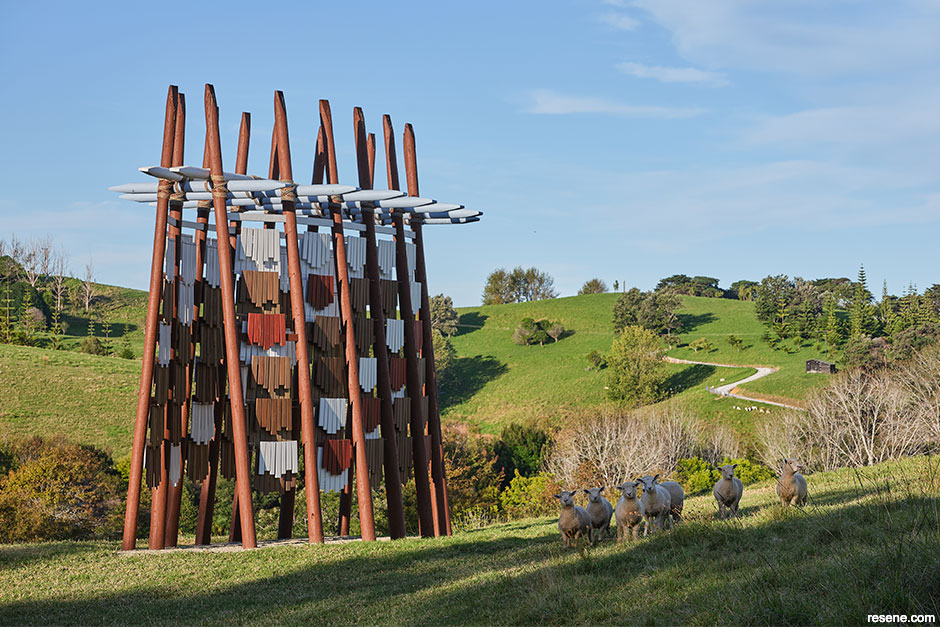
The folly was created as part of the annual Brick Bay Folly competition, which provides architectural graduates a unique opportunity to design a concept for a whimsical or sculptural structure that serves no formal purpose beyond bringing joy. Designed and built by architectural graduates William Creighton, Mathew Green, Chris Gandhi and Seth Trocio, Te Reo o te Hau was selected as the latest winning project. In many ways, their design does far more than simply bring joy. Through a strong connection to its site, it beautifully weaves in storytelling, thoughtful considerations of sustainability and a reverence for local iwi Ngāti Manuhiri’s cultural heritage.
Previous Brick Bay Folly teams have been made up of two or more students who grew up together or were classmates in university. The latter was the case for this project team, who found one another during their architectural studies at Victoria University of Wellington. Originally hailing from different cities, they drew from the diversity of their backgrounds to bring a shared vision for their folly to life. And unlike the many past folly teams, they were able to benefit from having some previous experience in woodworking and construction among their ranks.
Matt Green, who works for Hierarchy Group, grew up in Christchurch. He didn't always want to be an architect, but it was something he figured out as he got older. “I was interested in graphics, information and communications technology (ICT) and woodwork. I finished school soon after the 2011 Canterbury earthquakes occurred and decided to start a building apprenticeship. Four years later, I was qualified but keen to keep upskilling. I began my Bachelor of Architecture studies at Victoria University of Wellington and never looked back,” he says.
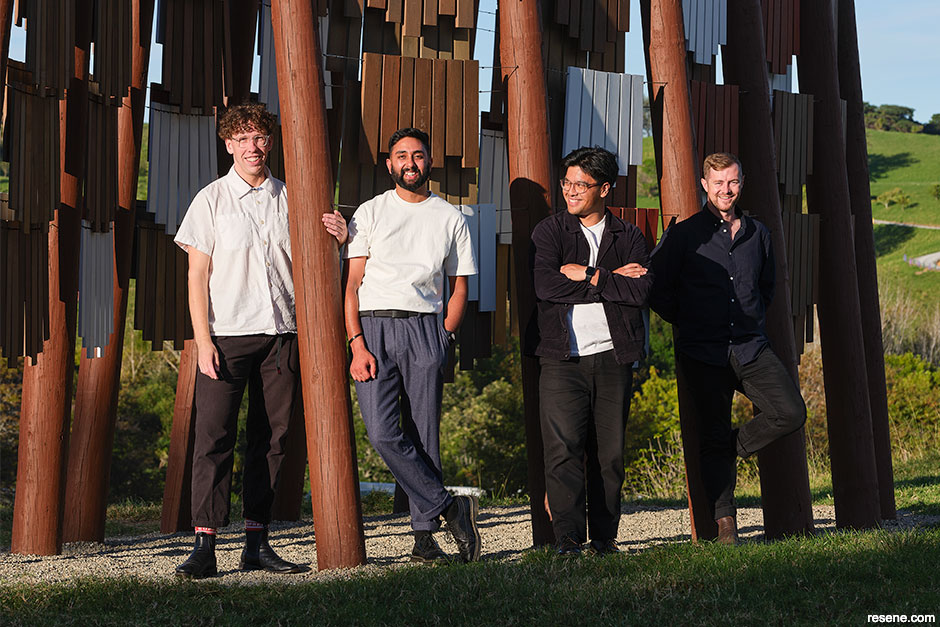
Seth Trocio was born in Manila, Philippines and immigrated to New Zealand’s Hutt Valley when he was seven before choosing to study architecture at Victoria University of Wellington. Today he works for Warren and Mahoney Architects. “Growing up, I was exposed to two very different cultures. In terms of career, architecture became a sort of outlet for my creativity and interests in the built environment and how our identities, cultures and history shape it.”
Chris Gandhi grew up in Porirua and now works for Athfield Architects in the firm’s Wellington office. “When I attended Aotea College, I found interest in courses that allowed me to explore my ideas through physical making, like metalsmithing and woodwork. My interests in the construction industry led me to apply for a building science course. However, in the first year of university, my courses also exposed me to architecture, landscape architecture and interior architecture. Through that, I found myself enjoying the design process more and the critical thinking involved when faced with architectural and contextual complexities. This led me to take the leap into architecture instead.”
William Creighton grew up in Dunedin and currently works for Tennent Brown Architects in Wellington. “I didn't always want to be in the architecture field, but both my parents are keen heritage conservationists, so I grew up in a similar space and knew I wanted to pursue an education that would allow me to work on built environments.”
He says what first united the team members to submit a project design was their mutual desire to enter the competition. “Matt spearheaded the initial process of coming together as a team. Part of why he thought we would work well together was due to our range of skills, from construction to detailing to colour work.
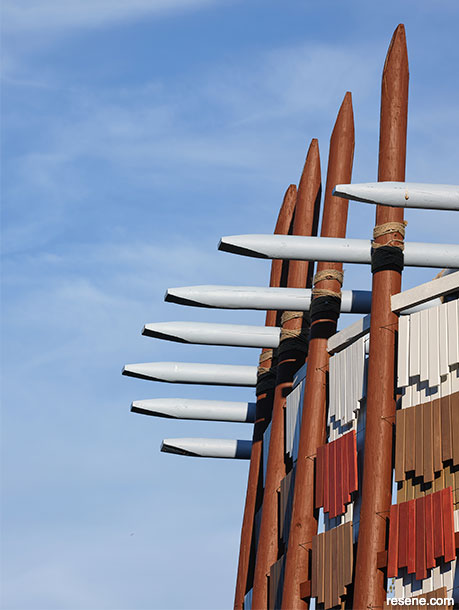
The project team was interested in ways they could connect the folly’s structure to its site and weave in Māori narratives. The combination of Resene colours they selected play a major role in uplifting the cloak and help to express its layered movement. Most of the hues help the folly blend in with its surrounding environment while the addition of Resene Porcelain brings touches of white to contrast and guide the eye upward and into the sky.
Vertical poles stained in Resene Waterborne Woodsman Dark Oak CoolColour, horizontal longitudinal poles painted in Resene Lumbersider Low Sheen Porcelain CoolColour, horizontal transverse poles in Resene Lumbersider Low Sheen Rock Blue CoolColour, stained shingles in Resene Waterborne Woodsman tinted to Resene Whero, Resene Driftwood, Resene Nutmeg and Resene Pickled Bean and painted shingles in Resene Lumbersider Low Sheen Porcelain CoolColour.
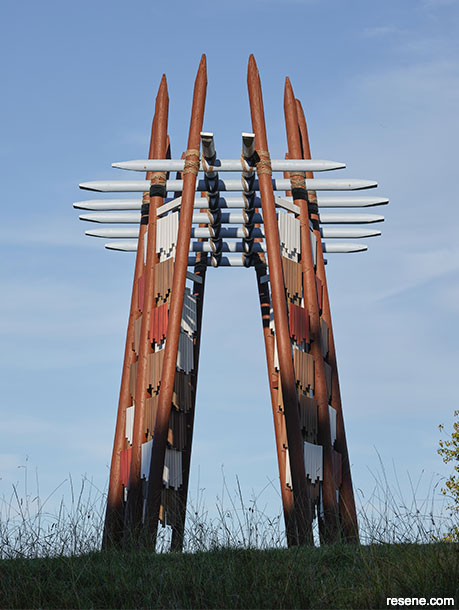
‘Giving a voice to the wind’ was a key concept that Chris, Matt, Seth and William wanted to achieve through their design. The folly’s outer kākahu (cloak) is comprised of layers of recycled kwila ‘shingles’ that were salvaged from former decks around Christchurch. The team removed nails, cut, sanded and refinished the kwila in Resene paints and timber stains that both blend in and contrast with the surrounding landscape. Each shingle is fixed to a tensioned wire in a way that allows even subtle breaths of wind to affect their movements, and as a result, become audible. The structure that holds the kākahu draws from the history of boatbuilding that took place on site. The art of waka construction informs the primary structure, with sisal rope lashings being used as a way to bring the folly together. The lashings tie large cross beams together, strongly expressing the overall form and its connection to the chosen materials.
Vertical poles stained in Resene Waterborne Woodsman Dark Oak CoolColour, horizontal longitudinal poles painted in Resene Lumbersider Low Sheen Porcelain CoolColour, horizontal transverse poles in Resene Lumbersider Low Sheen Rock Blue CoolColour, stained shingles in Resene Waterborne Woodsman tinted to Resene Whero, Resene Driftwood, Resene Nutmeg and Resene Pickled Bean and painted shingles in Resene Lumbersider Low Sheen Porcelain CoolColour.
“Early in the design process, through a kōrero (discussion) with Delma O’Kane from Ngāti Manuhiri Settlement Trust, a pūrākau (mythological narrative) was gifted to us. Brick Bay put us in touch with Delma after our initial concept was proposed. From this consultation, design adjustments were made to better reflect the kaupapa (mission) of the project in alignment with the gifted pūrākau.”
The team says Te Reo o te Hau was inspired by nearby Mangatawhiri (Omaha Beach), Mangatawhiri refers to the kōkōhau (wind) which sweeps across the bay. The shape presents a kākahu (cloak) that imbues the wind into the landscape by allowing it the chance to be seen and heard rather than just felt.
Central to the project was finding a way to embody the wind’s voice within the folly’s design. Through the use of tension cables, sections of timber panels hang freely to create an interplay of movement in response to the breeze as it flows through. This was intended not only to embody the cultural narrative, but to connect those experiencing the folly to the unseen aspects of nature that are always present on the site. The use of recycled decking panels made it so that the folly effectively became an oversized wind chime and brought a whimsical element that engages visitors in an interactive and immersive experience.
The pūrākau also informed the patterning on the kākahu (cloak) and deepened the team’s understanding of the site. “Nearby Te Hauturu-o-Toi (Little Barrier) is the final resting place of the God of Winds – and a cloud rests over it, almost like a crown,” explains William. “The diagonal pattern runs up the kākahu to give the effect of the folly lifting as the wind from Te Hauturu-o-Toi pushes under it. Each assemblage of layered shingles has been painted or stained in one of five Resene hues. In this way, the folly takes on multiple meanings; not only is it an expression of the wind and its voice, but each shingle inherits the role of a feather.
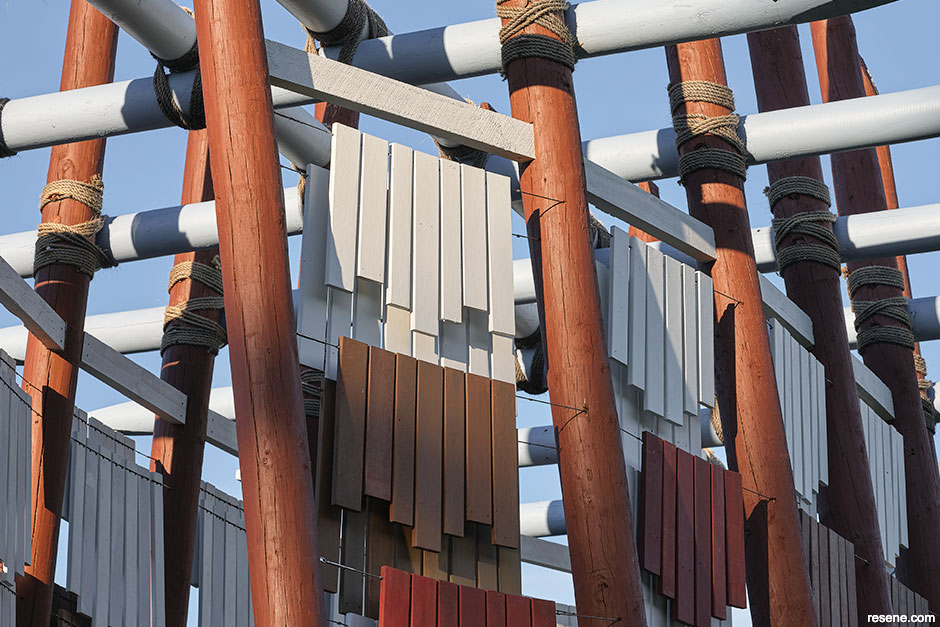
Collectively, it's these feathers that provide the appearance that a kākahu (cloak) is draping over the structure, which grounds it within the material’s history and its current resting place – above the whenua on site. The nature-inspired tones were selected to connect the project with the cultural narrative of the site. The stronger colours, such as Resene Waterborne Woodsman Dark Oak and Resene Waterborne Woodsman Whero, give the folly presence from a distance. Up close, the transparency of the stains allows the natural grain of the refinished recycled timber to show through.”
Sustainability was another key consideration throughout the design and construction process. By salvaging and repurposing the kwila panels, the team minimised waste. Rigorous testing of materials, paints and stains ensured both the aesthetic and impact of the folly were resolved early in the design phase. Where possible, local or recycled materials were prioritised and simple construction methods reduced unnecessary waste.
The project construction took place over the course of four weeks and saw the team members travel from different corners of the country to meet at Brick Bay. However, severe weather hit New Zealand’s North Island mid-build and the team found themselves without power for five days.
“The weather turned out to be quite the challenge during the project,” admits Matt. “There was a ‘weather bomb’ a week or so before Cyclone Gabrielle which put us under pressure to rearrange the project timeline. The new plans all worked out quite well, and as Cyclone Gabrielle rolled through, we were able to put down the tools for a few days. I think another big challenge of the project was the logistics, but Seth managed those seamlessly.”
Because of the weather conditions, William got stuck in Auckland on his commute to Brick Bay. “The cyclone meant the road was blocked and I ended up missing a few days on site. Once the road was cleared, I relocated closer to Warkworth for the remainder of the on-site portion of the build. Construction itself was less affected, as the cyclone’s timing wasn't too impactful. It may have forced us to take some time off, but at least the concrete was already set so the structure was strongly in place by then.”
Aside from the impact of Cyclone Gabrielle, Seth agrees that the biggest challenge was coordinating logistics across all the different cities. “I took the lead on the project management side of things and focused on mainly ensuring we stuck to our budget, documented progress to discuss with our mentors and adjusted our programme and timelines for both the off-site and on-site phases of the project. Each team member fell into a role quite naturally as the project started to pick up, as each one of us brought our own specific set of skills. Because of that clarity, communication was really effective and efficient between the team, mentors and Brick Bay.”
“My favourite part of the project was being on site and watching the project come to life. It was truly special. We did about six months of work in the background to ensure the project would be a success – and it was well worth it. I also enjoyed watching the team come together to build the folly. Being the only member with construction experience, it was cool to see the other guys learning and enjoying the work,” says Matt.
William says his favourite part of the project was working alongside his teammates. “Spending time in the sun up north together during February was really fulfilling. Architectural practitioners don't often get the chance to construct their own projects, which is a real shame. This opportunity meant we not only grew as designers but as friends, too. The respect you gain for each other through the problem solving is also something not to be overlooked. We were very fortunate to work well together as a team, especially given we are spread across the country.”
Whenever you attempt something new for the first time, there are always plenty of lessons learned. One of the major advantages of completing a Brick Bay Folly is that architectural graduates who are early in their careers get to take in these learnings and apply them to their future work. With no real client involved and plenty of mentors to guide them through the process, they’re free to push themselves out of their comfort zone and through any fear that they might make mistakes along the way.
“One thing I learnt – and I'm sure the rest of the team did, too – is to ask a lot of questions from mentors and specialists but also allow enough time to test those ideas within the budget,” says Seth. “In the midst of all the work of sanding, painting, stacking and shipping, it was hard to see the end goal when we were labouring away. Huge props to not only our team but the friends, coworkers and family who helped with some of the most tedious parts of the build. My favourite part, though, was the sun beaming down on us on site. Each day, we slowly saw the true scale of our idea and design come to life. That will definitely be a core memory for me from this experience.”
Keith Mann, an adjunct lecturer and the head of the architectural workshop at Unitec’s School of Architecture, was one of the project mentors. He helped the project team overcome the challenges of turning their concept into reality since the folly was the first time building a design at scale for most of the team members. “The transition from ideas to a physical built form is a multifaceted process,” says Keith. “The team initially gains an appreciation for the characteristics of materials and construction. A process of iterative models of scale are constructed to identify material behaviours, investigate strengths, weaknesses and limitations, balancing creative thought with practicality. This is underpinned by a collaboration with mentors and industry professionals, who help the team navigate the complexities of the real-world construction which ultimately bring the folly to life.”
Since the project’s design demanded the preparation, painting and staining of more than 1000 pieces of timber, the build also taught the team members plenty about Resene products, too. A major learning that many Brick Bay Folly students have taken away from their builds is that while paint, wood stains and other coatings seem flat, they do have thickness – and this can add up and have a significant impact on a project’s final built dimensions in ways that might be overlooked in design drawings. Others have learnt to navigate their way through moist and cold conditions – and witnessed the effect those conditions can have during application. Luckily, Resene staff provided plenty of support to help the team understand the qualities of different products, along with each of their opportunities and limitations, so the students could gain new insights that will help them when preparing project specifications in the future.
“Resene provided amazing support during the project. Their service and help was invaluable and they gave good advice around paints and stains,” says Matt.
“We appreciated Resene’s generosity towards the project through sponsorship, donated products and mentorship. Consultations with staff at the Resene ColorShop whenever we needed materials were seamless, too. This took one more stressor away from us on a project that had a lot of complex moving parts,” adds William.
Since completing their folly, the project team members have been busy putting in their hours as architectural graduates and dreaming about what the future of their careers might bring. “I am currently working on a heritage project in Wellington and completing the folly brought about insights to the adaptive reuse of our built environment and activating old and new urban fabric through considerate design,” says Seth.
“I have been mostly gaining experience at the public scale designing civic spaces, but I have an itch for working at a smaller scale after doing the Brick Bay Folly,” says Chris. “Whether it be a project that sits within the realm of architecture or outside of it, the reason I want to work at a small scale is to be able to craft the finer details that may typically be overlooked on larger-scaled projects.”
“In the future, I see myself working on public projects and homes, but I am open to all project types. I love working with clients to bring their projects to life – whatever they may be,” says Matt.
“I'd love to work on more temporal installation work, but more urban-centric next time,” says William. “There are increased limitations when you're in a densely-populated environment, so I think this would be a good challenge. There are a few collectives working on this overseas, like Antepavilion in the UK. They do some really humorous work that toys with politics and whimsy simultaneously, and it’s quite a laugh!”
Not only was Te Reo o te Hau a finalist for the Exhibition and Temporary Structures category at this year’s Designers Institute of New Zealand (DINZ) Best Design Awards, but it was also recognised with the Resene Total Colour Landscape Award this year.
For those interested in engaging with the interactive experience that Te Reo o te Hau offers, the folly can be visited in person as part of the Brick Bay Sculpture Trail. Visit www.brickbay.co.nz for more information.
The team members behind Te Reo o te Hau share their favourite Resene paint and wood stain colours that feature on the project:

William Creighton
“I really liked using Resene Rock Blue. It feels happy, even for a cooler colour. Plus, it blended well into the sky on site. The sky blue you get on a clear day in Aotearoa is really special, so it's great to have a paint colour which fits so well with it.”

Chris Gandhi
“My favourite Resene colour we used was the Resene Waterborne Woodsman Whero timber stain. Including this rich, deep red colour on our folly beautifully contrasted with the landscape, and I could see myself using this colour on a timber weatherboard façade.”

Matt Green
“My favourite incorporated in the project was the Resene Waterborne Woodsman Whero stain. We used it on the 8m poles, and when Chris and I were first coating them, we were amazed how much the stain transformed the timber. The natural grain and the rings from milling showed through which gave these poles a presence.”

Seth Trocio
“I really love all the wood stains we used, like Resene Driftwood, Resene Pickled Bean and Resene Nutmeg. I tend to lean more towards natural tones and these colours worked really well with the repurposed kwila decking boards. The variations in the grain resulted in a façade full of depth, and the pops of colour heightened the overall character of the folly.”

Images: Sam Hartnett
This is a magazine created for the industry, by the industry and with the industry – and a publication like this is only possible because of New Zealand and Australia's remarkably talented and loyal Resene specifiers and users.
If you have a project finished in Resene paints, wood stains or coatings, whether it is strikingly colourful, beautifully tonal, a haven of natural stained and clear finishes, wonderfully unique or anything in between, we'd love to see it and have the opportunity to showcase it. Submit your projects online or email editor@blackwhitemag.com. You're welcome to share as many projects as you would like, whenever it suits. We look forward to seeing what you've been busy creating.
Earn CPD reading this magazine – If you're a specifier, earn ADNZ or NZRAB CPD points by reading BlackWhite magazine. Once you've read an issue request your CPD points via the CPD portal for ADNZ (for NZ architectural designers) or NZRAB (for NZ architects).